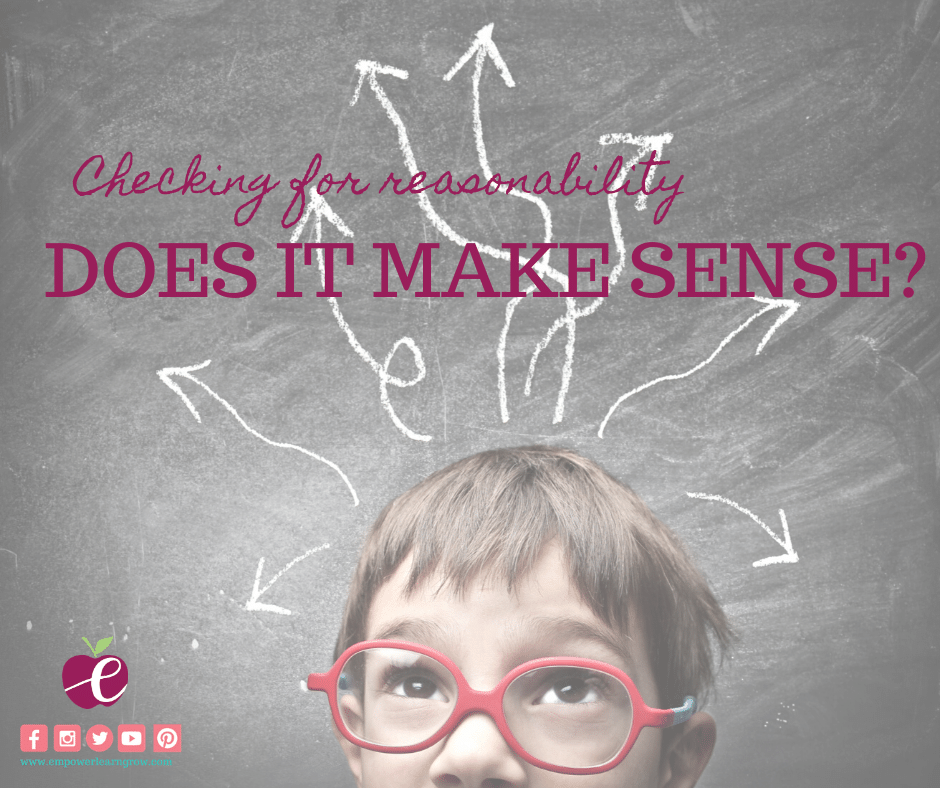
02 Feb Does Your Answer Make Sense?
“Yes.”
That’s the answer I received when I asked a third grader if his answer made sense. Our problem involved grandma eating pizza for dinner last night. The ultimate question was, “How many slices of pizza did grandma eat?”
It took a lot of self-control to keep my face neutral and to not give away what my inside voices were screaming, “You seriously think Grandma ate 75 pieces of pizza in one night???! Are you crazy?? Who is your grandma, a WWF superstar???”
But instead, my face stayed neutral and my reply was, “Interesting. Let’s look back at the problem and I’d like to hear how you arrived at 75. Let’s look to see where 75 is on the number line and how far or close it is to the parts in our equation.”
I’m not as bothered by the inaccurate computation that led to the answer of 75 as I am that this particular child had no problem with the final answer being out of the realm of reasonableness.
We see this in younger grades when kids make estimates or guesses and say things like, “a million!” when referencing the number of candy corn in a small jar.
We see it often in the intermediate grades when working with decimals and fractions, showing their lack of understanding about taking parts of parts (fraction times a fraction) and believe multiplication always gives us more or bigger totals.
In both cases, it is more about understanding what the numbers and operations mean and require. We can complain all day that this is another example of how our students don’t have number sense, but until we all agree that we must be a part of the solution and not on the blame train, we will continue to experience situations like these.
So what can we do about it? Here are some ideas I find very helpful.
Discuss reasonableness BEFORE, DURING and AFTER students solve.
Many of us include reasonableness at the end of problem-solving and we really only engage with students if we notice their answers aren’t at all reasonable. I do think checking for reasonableness at the end of a problem is still a solid practice, but I’d like to argue that it should happen THROUGHOUT the mathematical process. We should be asking about reasonableness at the beginning of our problems. Some of my favorite questions, regardless of age are below.
“What do we already know about our answer?” I’m trying to get students to talk about the ‘about’, the ‘estimate’ and the ‘in-between,’ but beyond that, I’m trying to get students to think about the size of the answer in relation to what we know about:
- The parts
- The context
- The non-example
The Parts (an intermediate example):
Let’s say we know that Daniel had to save a tenth (.10) of his weekly earnings $231. How much does he need to save?
What do we already know about the answer before doing any of the computations? Here are some possible student and teacher interactions.
- The answer has to be smaller than $231. (T (my favorite question): Why?) Because he made $231 and we are only saving a part of it, so we know what we save isn’t the whole amount and therefore it must be smaller than $231. (T: How do you know we are only saving a part?) We know because a tenth is a part of a whole. So, we are only saving a part of a large number.
- The answer will be larger than $20. (T: how do you know?) I know because a tenth of just the $200 is $20, and we are taking a tenth of more than $200, so it has to be larger than $200.
- The answer will have a decimal. (T: why?) I know because if I take a tenth of $1, I get 10 cents, and the last digit is $1, so I know there will for sure be a decimal to show that ten cents.
The Parts (a primary example):
Jade’s grandpa had 14 stamps in his collection. 6 of the stamps got lost when grandpa moved. How many does he still have?
- The answer has to be smaller than 14. (T: why?) I know because he lost some, which means some went away. Our answer wouldn’t be larger than the number we started with, that wouldn’t make sense. The problem doesn’t say he got more, it just said he lost some, so I know the answer will be smaller than 14. (T: So could the answer be 2?) No, I don’t think so. If he lost 6 and only had 2, I can do that in my head and I know that’s 8, not 14, so I know it will definitely be larger than 2, but less than 14.
The Context:
Let’s say there were 39 boys and 47 girls in the afterschool choir. To prepare for the choir concert, the custodian has to put out chairs for family attending. How many chairs should he put out?
- The answer will most likely be more than 70. (How do you know?) Well, I know that if I just look at the tens place, 30 +40 =70 and I would assume that each child has at least one family member attend the concert. But, some of those boys and girls could be brothers and sisters, so I’ll assume that accounts for the 9 and 7 extra I didn’t account for yet. Plus, I know that most likely many of those children will have more than one family member attend, so I know our answer will be larger than 70. This child utilized the parts and the context to determine what would be reasonable.
The Context:
A bus can hold 40 students. There are 315 students in grade 4. How many buses will they need to go on a field trip?
- Well, I know they are going to need at least 8. (T: how do you know?) When I think about 40 X 8 I get 320, which is bigger than 315, but that means 7 would still leave a few kids without a bus and we also have to have chaperones!!!
The questions I could ask at the start could be:
- What do we already know about our answer?
- Will our answer be larger or smaller than ______ and how do you know?
- What could our answer NOT be? Why do you think so? This is one of my FAVORITES. Discussing what it can’t be is just as important as what it could be. This is about utilizing the non-example.
- What would be a silly answer? This is a great one for our younger students. The more we discuss ‘silly’ answers, the better they will become at making reasonable estimates, but we have to help them to know why those answers are silly. That leads me to my next point.
Get these, along with other teacher questions via the download below.
Discuss WHY answers are NOT reasonable and why they ARE reasonable.
Use tools such as number lines, manipulatives, hundreds grids etc. to defend the thinking. Using visuals will help students to make sense of the numbers and their sizes. When students know there are 13 red apples and they pick 7 more, it is unreasonable to say there will be 50 apples in the end. But, this makes sense to me. Does it make sense to them?
I’ve stopped asking, “Does that make sense?” as my only question. This is a closed question and it gets me into trouble. It leads to single word answers, “yes” and “no.” Instead, I follow up that question with, how do you know? Tell me more. Prove it. I often think students respond yes because that seems like what they are supposed to say, but really they haven’t thought about it.
I can use a number grid or chart to point to 13 and then ask students, is 7 a lot or a little to add? It’s seemingly a little, so now let’s look at 50 on the same chart. WOOOOAA, it’s a long way away from 13!! Do you think we have to move more than 7 spaces to get ALL THE WAY to 50? Most kids should now see why 50 is not reasonable, but what about the ones who still don’t see it?
PROVE IT AND HAVE PATIENCE. TELL YOUR FACE.
Gosh, it sure does feel terrible when you think something makes sense and everyone around you tells you it doesn’t. Tell your face and tell your tone to take a chill pill. Yes, I’m just as bothered as you are that they still don’t see that their answers are unreasonable, but shaking my head in an attempt to get them to follow my lead is not making anyone feel better. As the student is working through their own understanding, they need a teacher to keep the thinking alive. We do that with our face and with our next steps. Just telling students that it doesn’t make sense or “No, it can’t work like that, ” etc. is not helping our cause. I want to protect each student’s mathematical identity while strengthening their reasoning and number sense. So, when they still don’t know why their answer doesn’t make sense, or they think 50 is really close, then we just need to help them prove it.
“So, if 50 is WAAAAAAY down there (pointing to number line), and I have to add 7, do you think I can get there in just 7 more?”
S: Yes!
T: (with a neutral face and neutral tone): Well let’s try it and see what happens. Why don’t you count with me 7 more and we will see where we land.
The student will then count and see that 50 is still far away.
T: Hmmm. That’s interesting. Would you like to revise your idea? Do you still think 50 is reasonable?
S: I’d like to change my mind. 50 is way too far away !!!
T: Wow, way to persevere and think through that. I just love how you didn’t change your mind just because everyone else disagreed. You used your math tools to prove your idea and you weren’t afraid to change your mind! What a great mathematician.
These types of interactions keep a student’s identity in check while also building his/her number sense. We can do this with number charts, manipulatives, etc. When students don’t know, they need time to play with the numbers, see the numbers, and prove the thinking. This is not something we can fix by merely working on rounding or better yet, shaking our head yes when we ask, “Does that make sense?” We shake our heads in hopes of conveying that, of course, they should be agreeing with us, so when they hesitantly agree with us we breathe deep and think, “Oh good, we can move on…” But, the reality is they only said yes to match our head nod. That student has now learned they can’t trust their intuitiveness about numbers and they should solely rely on their teacher’s opinions to make up their minds. You and I see this every day in the classroom. Students watch our faces to decide if they agree, disagree, etc.
Let me guess, your biggest argument is: “I don’t have time!”
Well, my friends, if we don’t have time to build in these experiences with kids (even if it is one and one when the rest of the class moves on) then we really don’t have the time nor the right to complain about how unreasonable student’s answers are and how they lack number sense. We must be willing to help build this in students. It isn’t something that is taught in a single estimation lesson. Checking for reasonableness is so much more than rounding numbers, yet we seem to only do it when we are in estimation lessons. It is something that is BUILT over time, every day with every math concept. If we have time to do 20 problems on a workbook page, all in which a student understands the computation but has no idea why his/her answers are reasonable /unreasonable, then we have merely helped them to become calculators, not mathematicians.
Consider implementing some fantastic math routines such as About or In Between. This is a math routine by John SanGiovanni. You show students an expression such as 39 + 47 and ask them about how much the answer would be or in between what two numbers would the answer be. I’ve done this warm-up many times and kids have such interesting ideas. This is building up their flexibility with numbers so that they are able to think about the reasonableness of answers.
Sarah says 90. I rounded 39 to 40 and 47 to 50. 40 + 50 = 90
Another student, Eduardo says, 87. I rounded 39 to 40, but then added another 40 and then 7 to get 87.
Cherie says, “I knew it had to be between 80-90. Like Sarah, I knew 90 could be possible, but really, it had to be less than 90 as I rounded both numbers up, but it had to be more than 8- because 30 and 40 equals 70, but I knew there was another 16 to add.
THE ONLY WAY TO GET STUDENTS TO THINK LIKE THIS IS TO GIVE THEM OPPORTUNITIES TO THINK LIKE THIS.
The more we give students a chance to think about numbers and quantities, the more flexible they will become. But, if they only practice these skills during an estimation lesson, it isn’t a part of what mathematicians really do.
To summarize:
- Ask if it is reasonable before, during, and after solving.
- Have students defend how they know or why they think so. Just because they say ‘yes’ or they say ‘no’ doesn’t mean they are really thinking.
- Ask more than one student. One kid is not representative of the whole. Really force yourself to ask multiple students to defend why or how they think an answer is reasonable or what a reasonable answer might be. This will build flexibility and help students to see how many different mathematicians think about problems.
- Keep your face neutral and capitalize on opportunities to build number sense.
- Practice. Once isn’t enough. One lesson isn’t enough. Do it every day.
Oh, my sweet friends, we can do this. We can be a part of the solution. Let’s not make time our excuse. Computation is, of course, important, but the reality is they have a calculator in their pocket forever to help them with this. Reasonability is a life long skill for which that Alexa or Siri won’t be able to help.
Go to it. Go be great. I want to hear how it goes and what road bumps or successes you encounter along the way. What other strategies are you using that we can add to these ideas? And don’t forget your free download of teacher questions to support reasonability. Just enter your email below.


Barb McMahon
Posted at 18:28h, 04 FebruaryAs always – GREAT ideas! I need to really work on my neutral face. Step one: Stop smacking my head. 🙂
Melissa Smith
Posted at 15:38h, 08 FebruaryGreat ideas! I especially love the idea of brainstorming what the answer can’t be. I have been working on reasonability this year and having students prove their answers. Thank you for even more tips on building this very important skill.